Chlorthalidone & Gout: Essential Facts & Management Tips
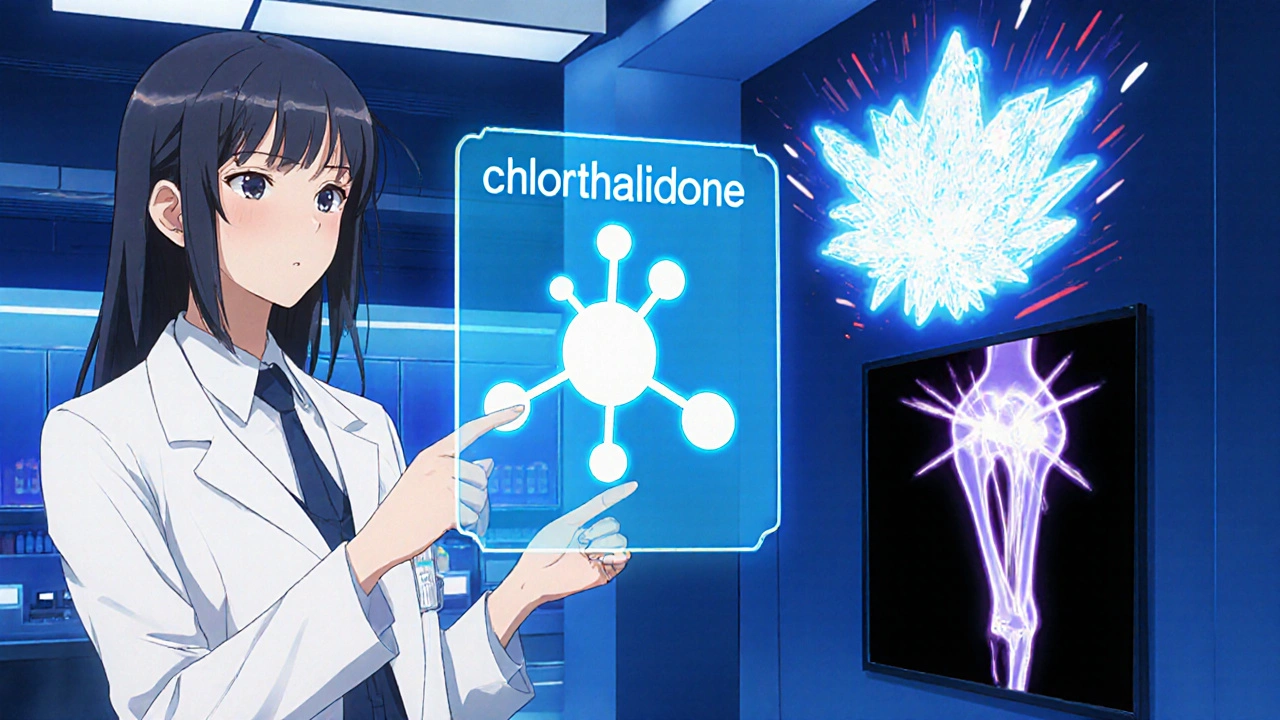
Chlorthalidone is a thiazide‑like diuretic commonly prescribed for high blood pressure and fluid retention. While it’s effective at lowering blood pressure, many patients wonder about its link to gout. This guide breaks down the science, highlights who’s most vulnerable, and offers practical steps to keep painful flare‑ups at bay.
Quick Takeaways
- Chlorthalidone can raise uric acid levels, increasing gout risk.
- The risk is highest for men over 50, people with kidney disease, or those already hyperuricemic.
- Regular blood tests, diet tweaks, and possibly adding a urate‑lowering drug can prevent attacks.
- Alternative blood‑pressure meds like ACE inhibitors or calcium‑channel blockers have lower gout‑trigger potential.
- Stay hydrated and limit purine‑rich foods to keep uric acid in check.
How Chlorthalidone Works
Chlorthalidone blocks sodium reabsorption in the distal tubule of the kidney, prompting the body to excrete more salt and water. This reduction in fluid volume lowers the pressure against arterial walls. The drug’s long half‑life (about 45‑60 hours) means it provides steady blood‑pressure control with once‑daily dosing.
Because it promotes sodium loss, the kidneys compensate by increasing the reabsorption of other ions, most notably uric acid. The result? Higher serum uric‑acid concentrations, which can precipitate crystal formation in joints - the hallmark of gout.
Why It Can Trigger Gout
The chain of events looks like this:
- Chlorthalidone reduces plasma volume.
- The kidneys reabsorb uric acid to maintain electro‑chemical balance.
- Serum uric‑acid levels climb, sometimes crossing the 7 mg/dL threshold for men.
- Monosodium urate crystals deposit in joints, causing inflammation and pain.
Research from a 2023 meta‑analysis of 12 randomized trials showed an average uric‑acid increase of 0.9 mg/dL in patients on chlorthalidone versus placebo. Another 2024 cohort of 8,300 hypertension patients found a 1.6‑fold higher incidence of gout flares when chlorthalidone was used as first‑line therapy.
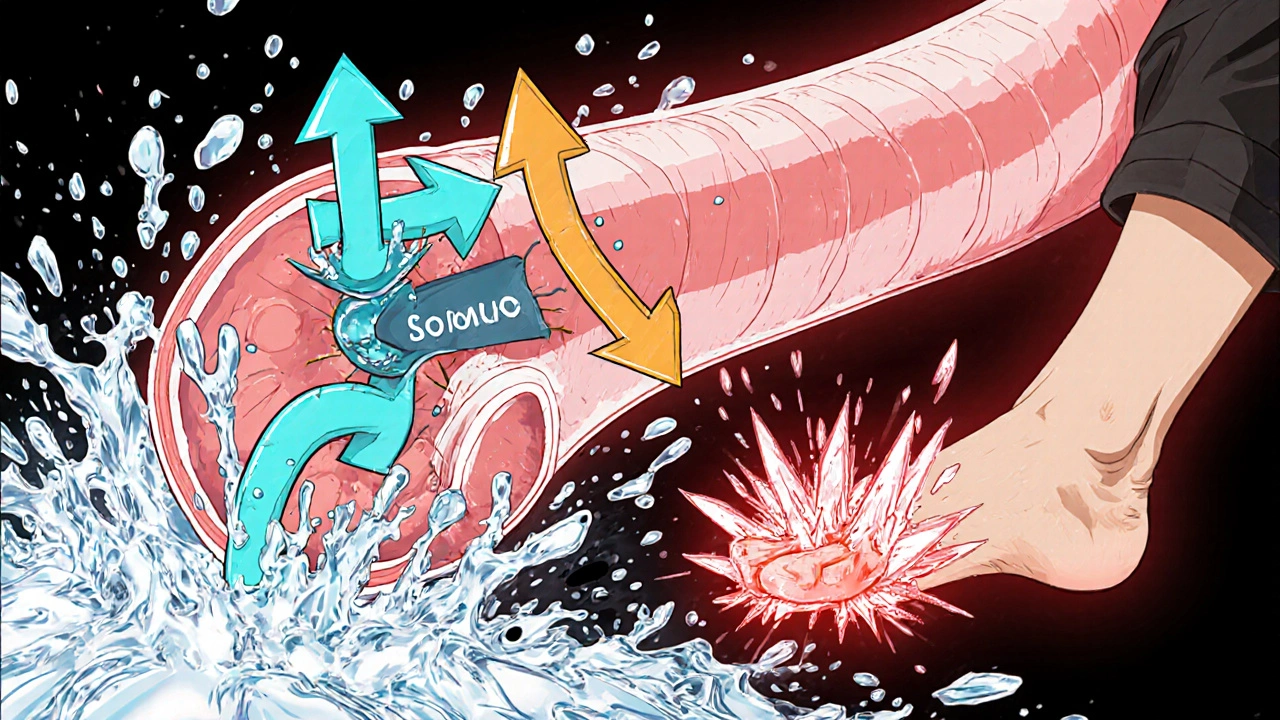
Who’s Most at Risk
Not everyone on chlorthalidone will develop gout. Certain factors tip the scales:
- Gender and age: Men over 50 have the highest baseline gout prevalence.
- Kidney function: Estimated glomerular filtration rate (eGFR) below 60 mL/min/1.73 m² reduces uric‑acid clearance.
- Existing hyperuricemia: Baseline uric‑acid >6 mg/dL for women, >7 mg/dL for men.
- Obesity: Higher body‑mass index correlates with increased uric‑acid production.
- Concurrent medications: Low‑dose aspirin, cyclosporine, and some chemotherapy agents also raise uric acid.
If you fall into any of these categories, discuss proactive monitoring with your prescriber.
Managing Gout While on Chlorthalidone
Below is a step‑by‑step plan you can follow:
- Baseline labs: Before starting chlorthalidone, get serum uric‑acid, creatinine, and electrolytes.
- Regular monitoring: Check uric‑acid every 3-4 weeks for the first three months, then every 6 months if stable.
- Hydration: Aim for at least 2‑3 liters of water daily; urine dilution helps excrete uric acid.
- Diet adjustments: Limit red meat, organ meats, seafood, and sugary drinks. Incorporate cherries, low‑fat dairy, and coffee, all shown to modestly lower uric‑acid levels.
- Medication review: If uric‑acid climbs above 8 mg/dL or you experience a flare, your doctor may add a urate‑lowering drug such as allopurinol or febuxostat.
- NSAID strategy: For acute flares, naproxen or indomethacin can reduce pain, but avoid chronic NSAID use if you have hypertension, as they may blunt the blood‑pressure benefit of chlorthalidone.
- Consider dose reduction: If blood‑pressure goals are met, lowering the chlorthalidone dose can lessen uric‑acid retention.
Never stop the medication abruptly without a doctor's guidance; sudden volume shifts can cause blood‑pressure spikes.
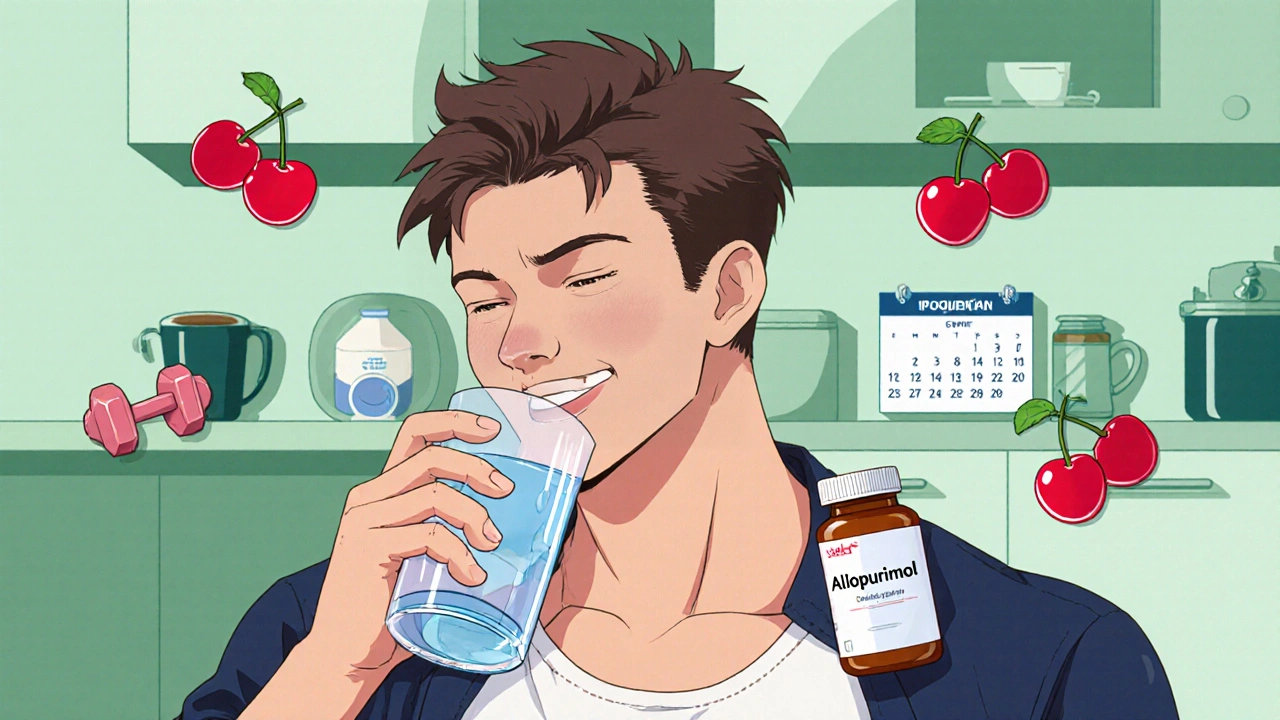
Alternatives and Safer Options
If gout becomes a recurring problem, discuss swapping chlorthalidone for a drug with a lower impact on uric acid. Here’s a quick comparison:
| Medication | Class | Typical Dose | Uric‑Acid Impact | Notes for Gout Patients |
|---|---|---|---|---|
| Chlorthalidone | Thiazide‑like | 12.5‑25 mg daily | ↑ 0.8‑1.0 mg/dL | Most potent antihypertensive; highest gout risk. |
| Hydrochlorothiazide | Thiazide | 12.5‑50 mg daily | ↑ 0.5‑0.7 mg/dL | Commonly used; moderate gout risk. |
| Indapamide | Thiazide‑like | 1.5‑2.5 mg daily | ↔︎ Small change | Effective for hypertension with lower uric‑acid effect. |
| Furosemide | Loop | 20‑80 mg daily | ↑ 0.3‑0.5 mg/dL | Used for edema; still raises uric acid but less than thiazides. |
Switching to indapamide or a calcium‑channel blocker (e.g., amlodipine) often preserves blood‑pressure control without aggravating gout.
Lifestyle Hacks to Keep Uric Acid Low
- Stay active: Regular moderate exercise improves insulin sensitivity, which helps the kidneys clear uric acid.
- Weight management: Losing 5‑10 % of body weight can drop uric‑acid levels by up to 1 mg/dL.
- Limit alcohol: Beer and spirits are especially problematic; a small glass of wine is acceptable for most.
- Choose low‑purine proteins: Poultry, tofu, and legumes are safer than organ meats.
- Vitamin C supplementation: 500 mg daily may modestly reduce uric acid, but discuss with your doctor if you have kidney stones.
These habits complement medical therapy and often reduce the need for additional drugs.
Frequently Asked Questions
Can I stop chlorthalidone if I get gout?
Stopping abruptly can cause a rebound rise in blood pressure. Talk to your prescriber about tapering or switching to a different antihypertensive before quitting.
How often should I check my uric‑acid levels?
Every 3‑4 weeks after starting the drug, then every 6‑12 months if results stay stable.
Is allopurinol safe to take with chlorthalidone?
Yes, they are often used together. Allopurinol lowers uric‑acid production, counteracting the rise caused by chlorthalidone. Monitor kidney function regularly.
Do natural remedies like cherry juice actually help?
Studies show that a daily serving of cherries or cherry extract can reduce gout flare frequency by about 30 %. It’s a useful adjunct but not a replacement for prescribed therapy.
What other drugs can raise uric acid besides chlorthalidone?
Loop diuretics (furosemide), low‑dose aspirin, cyclosporine, and some chemotherapy agents (e.g., vincristine) can also increase serum uric acid.
Understanding the link between chlorthalidone and gout empowers you to stay ahead of painful flare‑ups. By keeping an eye on labs, tweaking lifestyle habits, and collaborating with your healthcare team, you can enjoy both blood‑pressure control and joint comfort.

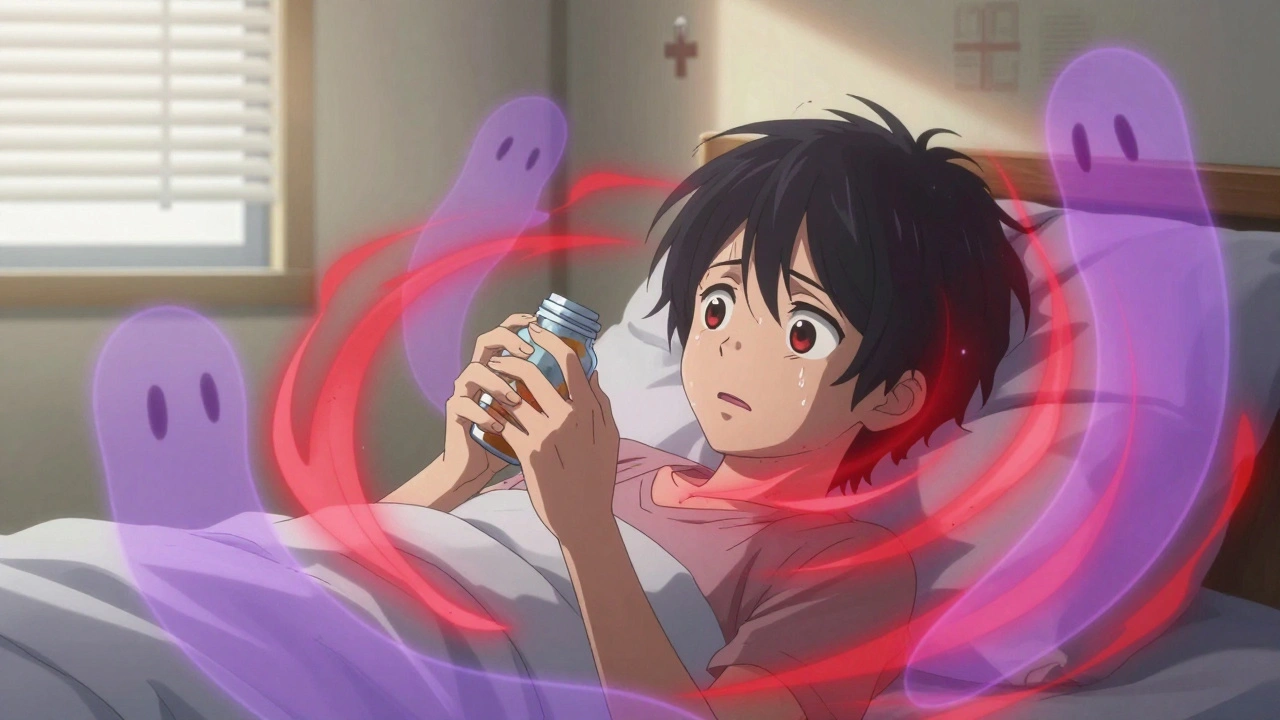

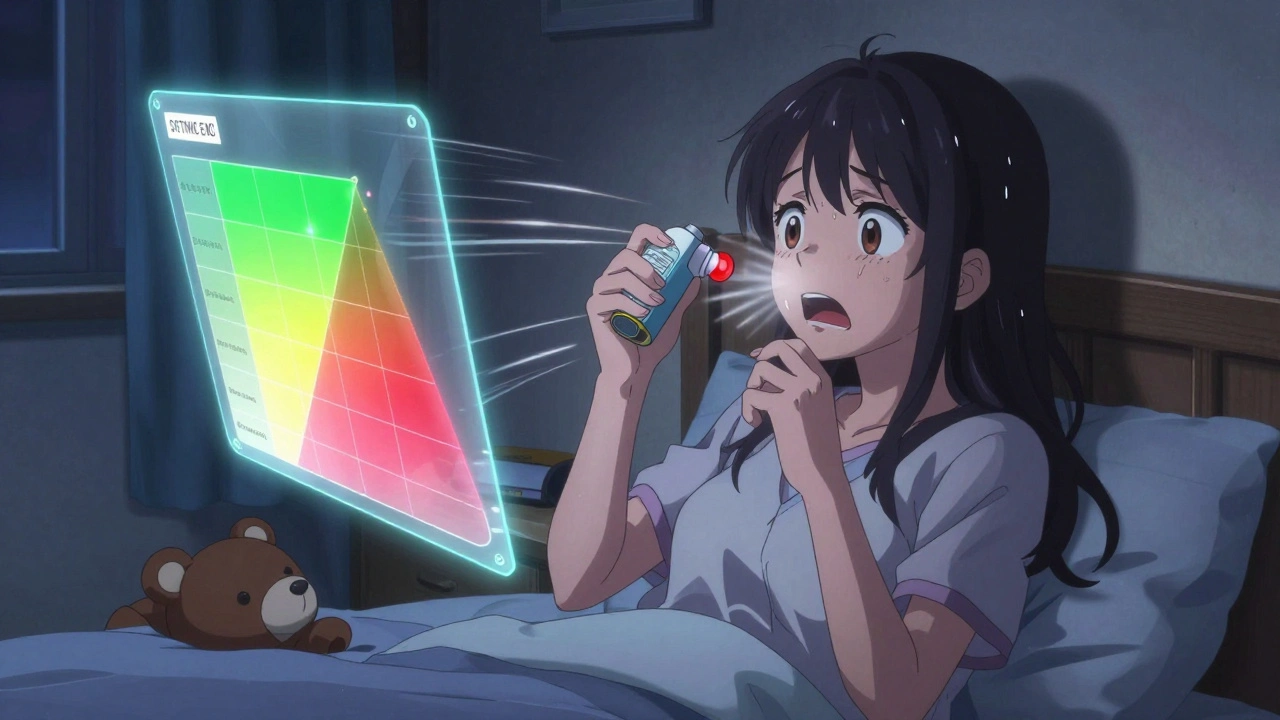
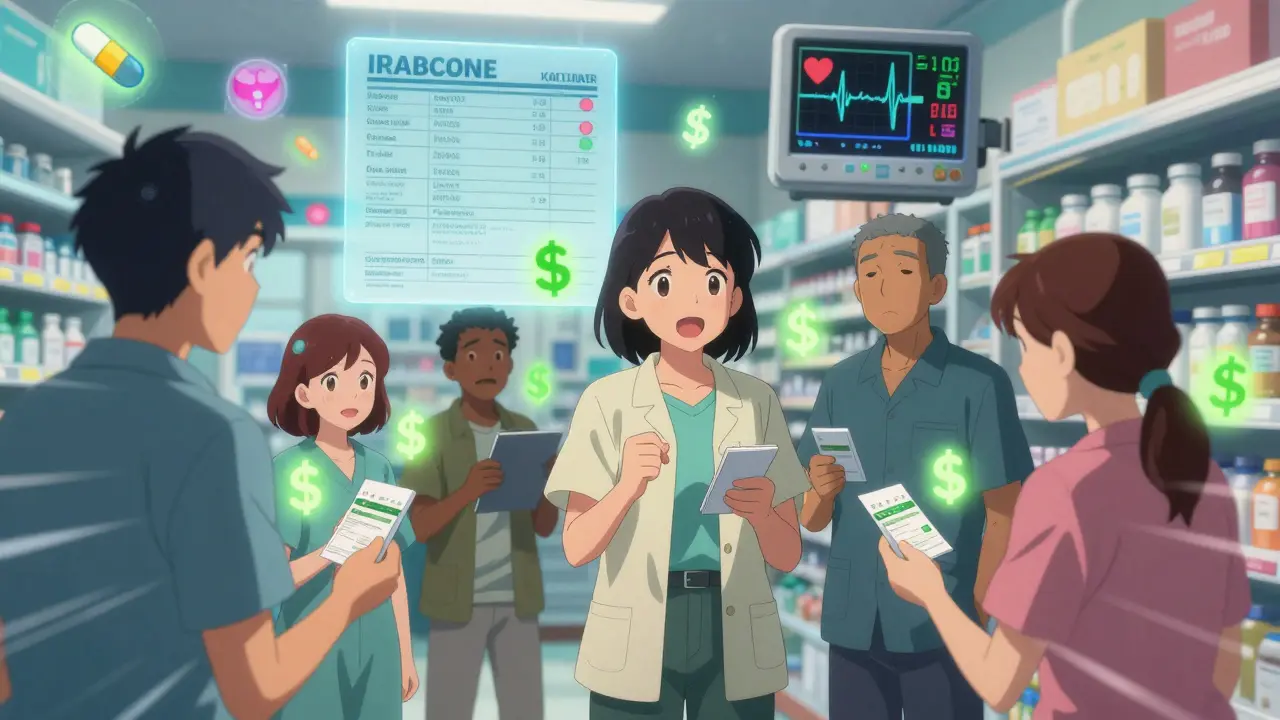

Comments
Leanne Henderson
October 25, 2025 AT 15:12Wow! Great rundown, and I love the practical tips!!! Keep them coming, especially the hydration reminder-it's a lifesaver!
Megan Dicochea
October 30, 2025 AT 05:19Good info but monitoring labs every few weeks can be a hassle
Suzanne Carawan
November 3, 2025 AT 06:32Oh sure, just add another pill and hope it cancels out the diuretic, because medicine is that simple.
Kala Rani
November 6, 2025 AT 17:52I don’t think the gout risk is that big you can handle it with diet alone
Donal Hinely
November 9, 2025 AT 15:19Listen, if you’re scared of a little uric‑acid spike, just ditch the thiazide and grab a calcium‑channel blocker-your joints will thank you!
christine badilla
November 13, 2025 AT 02:39I literally can't even think about another gout flare-my knees are screaming louder than my alarm clock!!!
Sunita Basnet
November 15, 2025 AT 10:12Integrating cherries into the regimen can modulate purine metabolism and reduce flare frequency significantly
Melody Barton
November 18, 2025 AT 21:32Enough with the fancy talk-just lower the dose if it hurts
Justin Scherer
November 21, 2025 AT 05:05Yeah, a small dose cut can keep pressure down and uric acid lower
Pamela Clark
November 24, 2025 AT 16:25Oh brilliant, another checklist of things to do-because we all have endless free time for labs and diet plans
Diane Holding
November 26, 2025 AT 23:59True, it's overwhelming
Manish Verma
November 30, 2025 AT 11:19Mate, our doctors should prescribe indapamide more, it's Aussie‑approved and gentler on the gout
Lionel du Plessis
December 2, 2025 AT 18:52Exactly there’s less uric impact
Andrae Powel
December 6, 2025 AT 06:12I’ve seen patients successfully manage both hypertension and gout by pairing chlorthalidone with allopurinol and strict hydration
Jennie Smith
December 8, 2025 AT 13:45First off, kudos for the balanced approach-mixing meds with lifestyle is the sweet spot.
I’ve been on chlorthalidone for a year and the only thing that kept me from spiraling was the cherry juice habit.
Honestly, the taste is like birthday confetti in a glass, and it somehow tricks my body into flushing uric acid.
The key, though, is timing; sipping it right after your morning water bolus maximizes renal clearance.
I also swear by a modest 500 mg vitamin C tablet, which adds a citrus punch to the whole regimen.
Don’t underestimate the power of a brisk 30‑minute walk; it nudges insulin sensitivity and indirectly lowers purine synthesis.
On the medication front, my doctor kept the chlorthalidone at 12.5 mg instead of jumping to 25 mg, which made a world of difference.
When my uric‑acid crept up to 7.2 mg/dL, we introduced a low dose of febuxostat, and the numbers slid back down nicely.
The trick is not to panic and stop the diuretic abruptly, because the rebound hypertension can be brutal.
Instead, schedule a taper with your prescriber and monitor blood pressure every week during the transition.
I also cut down on beer-one canbrew a week is fine, but the weekend binge was the real culprit.
Protein wise, swapping steak for grilled tofu kept my muscle mass while dropping purine intake.
Hydration is non‑negotiable; I keep a 2‑liter bottle on my desk and refill it like a marathon runner.
If you ever feel a flare looming, a quick ice pack on the affected joint for 15 minutes can calm the inflammation fast.
Bottom line: treat your body like a high‑performance engine-fuel it right, lubricate it regularly, and it will run smooth even on chlorthalidone.